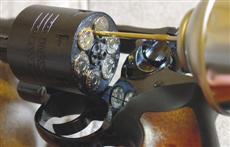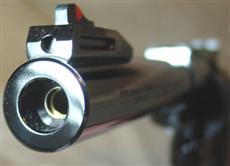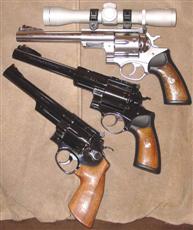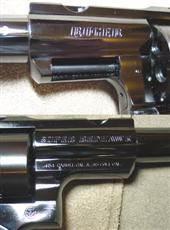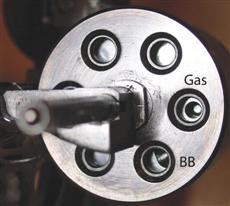Introduction In the 1950s Dick Casull and Jack Fullmer designed a large-caliber “ultimate magnum” handgun cartridge for big game hunting. They used the .45 Colt as the base design, but extended the cartridge casing and packed in more powder charge. This caliber would eventually be named the .454 Casull. Guns that chamber the awesome .454 can also chamber the .45 Colt. The .454 has twice the impact energy of the .44 Magnum and is pretty close to that of a .300 Weatherby Magnum rifle cartridge! This type of extreme power is ideal for hunting elephants, rhinos, grizzly bears and even drugged-up extraterrestrials with superhuman strength (see the film Alien Nation to understand). The cartridge can achieve 1803 fps with a 260-grain bullet and produce a muzzle energy of 1871 foot pounds — extraordinary numbers that would render Dirty Harry speechless. With all this power comes the most devastating recoil that you can ever imagine (about 75% more kick than the .44 Magnum). Only the most experienced magnum shooters can handle the ear-deafening, bone-jarring and wrist-damaging jolt. There’re only a few handguns manufactured to fire the .454 cartridge, among them are the 5-shot single action revolvers from Freedom Arms and Magnum Research and double action revolvers such as the Taurus Raging Bull and Ruger Super Redhawk. Due to the extremely high pressures the .454 creates, the Raging Bull can chamber only five rounds in order to expand the cylinder walls. The Super Redhawk has a wider and unfluted cylinder, therefore it can chamber six shots. Speaking of the Redhawk… Appearance Tanaka Works has produced a finely-made airsoft gas replica of the Ruger Super Redhawk in .454 Casull and added a very nice coating to the finish. The gun comes in an attractive cardboard/styrofoam box with the manual, BB loading tool, gas loading tube, hop-up wrench and small bag of BBs. The gun uses HFC134a gas and the cylinder holds up to 15 BBs. This model has a 7.5-inch barrel and a gorgeous Midnight Blue finish that resembles polished blued steel. The gun is constructed of ABS with a good portion of it being metal. Metal parts include: the cylinder and the attached assembly, hammer, trigger and trigger guard assembly, rear sight, part of the front sight, cylinder release button and some internal parts. The gun weighs 950g, and because the cylinder is made of sturdy heavy weight metal, the balance is evenly distributed. The grips are also ABS, but it has a semi-hard, rubber-like surface. In the center of the black grips are the imitation wooden panels which look very much like real wood. On the bottom of the grip is the safety lever. Sliding the lever to the rear puts the gun on SAFE and the trigger can be pulled only halfway; the hammer cannot travel all the way back to fire. Trying to slide the lever with your fingers is difficult, as it is recessed into the grip and is pretty stiff. You either need long and strong fingernails or a key to move the safety lever. The shape and construction of this replica is exact almost to the last details. I personally like the look of the Super Redhawk; it has a large and robust frame and heavy barrel, and the cylinder is massive when compared to that on the Smith & Wesson M29. The built is very solid right down to the grips. The contours are very smooth and even and there are no seams down the center. On top of the gun, just forward the rear sight, are recessed “cutouts” that are scope mount “rails.” Special scope rings are made for the Super Redhawk and can be attached to the rails. After market scope rings are available for the Tanaka Ruger model, though I’m not sure if real Ruger ring mounts will fit. The trigger is very smooth in both single and double action, though in double action the pull is a little heavy. When the hammer is cocked it makes a very metallic “clicking” sound, and the same metallic-type sound can be heard when the hammer is dropped. Rotating the cylinder while it is closed is smooth and it locks solidly in place with each turn. The front and rear sights are very well constructed and can be aligned easily in just about any lighting conditions. The rear has a white outline and is adjustable for windage and elevation while the front is fixed and has a small plastic red ramp insert. The Ruger logos and trademarks also have been copied to exact specs. Instead of describing them in details, you can see the photos yourself. The Midnight Blue Tanaka did an excellent job in trying to replicate the look of blued steel. The surface is deep black with a very shiny coating and has a slightly blurry reflection. It’s very smooth and in fact looks very much like polished metal. And polish is what you need to do in order to keep a mirror shine. The finish tends to attract prints and marks when the gun is handled, and every time I take it out for a shoot I have to wipe it clean afterwards. One disadvantage of this beautiful finish — and this is a big one — is that it scratches VERY easily. While writing this review and handling the piece, I lightly bumped it (by accident) against a metal surface and the result was a very small white mark on the barrel. However, I believe it is more susceptible to metal. I have a S&W M29 Midnight Blue (also from Tanaka) and was able to slip on a very tight Hogue wood grips without laying a scratch on the finish. As for attaching scope rings, I would recommend using tape (preferably black to match the finish) to cover the areas that come in contact with the metal rings. The Cylinder Releasing the cylinder was a little difficult because of the tight construction and stiffness. The cylinder movement isn’t smooth and doesn’t swing out or spin freely, but in time it can due to normal wear of the parts. When the cylinder is open, there’re six dummy brass cartridges “loaded” into the chambers. The cartridges are not whole bullets; Tanaka uses only the base of the casings to look realistic. They are fixed and are “linked” together. Five of the casings have the letters “WIN 454 CASULL” stamped on them. The sixth one says “GAS” and has a small hole cut out to accept the gas nozzle. There’re actually two parts to the cylinder: one is the internal which is fixed and houses the gas and BBs. The other is the outer which spins independently and is how the BBs are loaded into each of the chambers. In the center of the cylinder is the gas release nipple. When the trigger is pulled, the hammer strikes against the spring loaded pin, which then gives the nipple a quick tap and a small burst of gas spurts out on the opposite end of the cylinder. On the front end of the cylinder there’re six slots or “chambers” where the BBs can be hand-loaded individually. When the cylinder is rotated, two holes are visible (thru the slots) where 1) the BBs are loaded using the tool and 2) where the gas is released. The BBs are loaded using a loading tool which can hold 15 BBs. Now, loading the BBs proves to be the second most frustrating task you’ll face (the first is loading the gas, which I’ll explain later). The spring inside the cylinder is tight, and it’s nearly impossible to push all 15 shots in at once. I manage to get maybe 10 in with one push, but this isn’t always the case. When a BB is fired and the cylinder rotates, the internal spring pushes each BB forward to fill in any empty slot. As long as there’re BBs in the magazine, the slots will always be filled. Since the gun can hold 15, I use the tool to load 10 first, then for the remaining five I would hand-load the BBs individually into each slot. This method is useful when playing in the field, as you can “load as you go” by poping in the BBs thru the front without using the tool or even opening the cylinder. Loading the gas into a Tanaka revolver isn’t as easy as that of a GBB pistol. Because the frame of the gun blocks the gas can, the nozzle can be inserted only at an angle, making it impossible to load without the aid of the extended gas loading tube (included). To load the gas, the larger end of the gas tube is inserted into the gas can nozzle while the smaller end goes into the gas valve in the cylinder. When the tube is attached to the nozzle, the whole assembly is much longer and tends to wiggle from side to side, making it difficult to maintain a straight, vertical hold. This makes the whole setup very awkward and I always end up wasting some gas when loading. Performance For the setup I used HFC134 gas and 0.2g BBs and fired it in normal room temperature. I also let the cylinder warm up before firing. I set up a 6-inch diameter target and stepped back 16 feet before firing 10 shots in double action mode. If you’ve owned any Tanaka gas revolvers then you’ll know that accuracy isn’t their main attractions. I’ve managed to get only four rounds inside the inner 3-inch ring, with the remainder shots scattered about in the outer rings (see photo). I have five Tanaka revolvers and all of them are consistently inaccurate. Anyway, the reason I like them is because they are great replicas and are powerful. The FPS clocked in at an average of 330, with a high of 351. I found that the gun has to fire about 20-25 shots before it can achieve its average velocity level (first few shots were in the high 290s). I was able to get 60-65 shots with one charge. Hop up Tanaka revolvers such as the Colt Python and S&W M29 series have a fixed hop up, but the Redhawk series have an adjustable hop up. To access the hop up, first open the cylinder and then locate the small hex screw immediately above the barrel. Use the included wrench to turn the screw clockwise to increase the hop. Adjusting the hop is slow and difficult due to the location of the screw. The rubber hop up piece is located just inside the barrel. Conclusion Tanaka makes the finest airsoft gas revolvers in the world, and the Ruger Super Redhawk is no exception. The Redhawk may not be very accurate, but it makes up with great details and solid quality, plenty of power and, with the Midnight Blue coating, a gorgeous and realistic finish. Now you can own and shoot the “most powerful handgun in the world” (or at least a replica of it) without breaking your hand!
Comment on this review in the forums Last modified: Thursday, April 24, 2003 8:14 PM Copyright 2003 ArniesAirsoft
|

